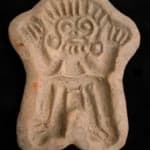Mayan Sculpture Mold, 300 CE - 900 CE
Terracotta
4 x 5
PF.6096
Further images
This work of art, an ancient sculptor’s mold, grants us a unique insight into the creative process of Mayan artists. Such a mold would have been used in the fabrication...
This work of art, an ancient sculptor’s mold, grants us a unique insight into the creative process of Mayan artists. Such a mold would have been used in the fabrication of small terracotta sculptures. Pressed into the wet clay, the intricately carved pattern of the mold would be replicated. The highly detailed pattern of the interior belies the smooth, abstract exterior. This particular mold replicates the front half of a frightful deity or spirit. With spiky hair standing on end and his arms raised into the air, this bizarre creature is clearly meant to frighten us, or perhaps, more likely, evil spirits. His mouth is open, his teeth exposed. Most likely, the molded clay, while still wet, would have been attached to a back mold defining the hindquarters of the creature, thus completing the sculpture. It is also possible that the back half would have been left unadorned, thus focusing attention to the molded design of the front. This little mold, as functional as it is, was once used to create images of gods and sacred animals. That idols worthy of worship or spirits able to frighten away evildoers could be created from this mold implies that the mold itself has some inherent power. Clearly, in the hands of a master sculptor, this mold has the power to embody and give form to the gods. Today, this mold is a relic of ancient artistry, transplanted from an ancient Mayan workshop into our hands, linking us directly with the creative process of long forgotten sculptors.





